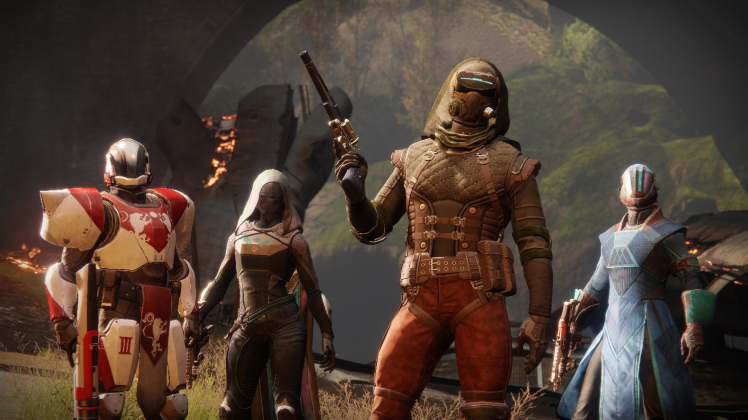
It was obvious from the moment it was announced that Destiny 2 wouldn’t be doing anything fundamentally different to its predecessor. Despite its enormous success the first Destiny earned a mixed reception upon its launch and was heavily criticised throughout its lifetime, even and especially by those that dedicated dozens of hours a week to playing it.
So while the sequel may seem unambitious, and relatively miserly in terms of new features, it will still prove more than worthwhile if it manages to streamline the original experience and add more content. And judging by the opening hours alone, it seems to have done exactly that.
As with any online-only game there was no way to properly review Destiny 2 before launch, especially considering that the first raid doesn’t go live until next Wednesday evening. The rest of the game switched on yesterday, at around 1pm in the UK, ahead of the official midnight launch. How smoothly that goes we’ll have to wait and see, but there were no major problems with the first one and the Destiny 2 beta seemed to go well.
The other problem with reviewing Destiny 2 is that we’ve already played the opening campaign level twice now, and you’ve probably watched it even more times via the official gameplay videos (not to mention all the streamers that leap upon the game the second the severs went live). But as overfamiliar as the opening has already become it is still a useful statement on just what developer Bungie is trying to achieve with Destiny 2.
Their stated priorities are improved storytelling, given there was almost none in the original; expansion, particularly of the open world patrol zones; and reinvention of flawed elements such as character progression and the competitive multiplayer.
Considering developer Bungie was previously best known as the creator of Halo it always seemed bizarre that Destiny never featured any coherent plot or characters, but the new campaign is almost falling over itself trying to rectify that oversight. The thrust of the story is that Earth has been invaded by a new faction of Cabal invaders, who destroy the Citadel and rob all Guardians of their ability to use Light. In other words they press the reset button on everyone’s character, so every player has to start again from scratch.
All of this is illustrated by much more structured set pieces than before, that immediately feel a lot more like Halo than anything in Destiny 1. The plot and characters are fairly bog standard sci-fi clichés though, where everyone is either a wannabe comedian (Cayde-6 is already almost unbearable) or stoic hardass whose every utterance seems more portentous than the last. There’s a certain sense of desperation in the game’s attempts to add more personality to its world, and while that’s preferable to nothing at all it hasn’t really grabbed us so far.
Where Destiny 2 shows unequivocal improvement though is in its open world areas. These were always impressively large but also largely empty – with only some dull fetch quests and the occasional public event to liven things up. Destiny 2 adds two important new aspects in the form of Adventures and Lost Sectors. Adventures are basically proper side quests, with not only more varied objectives but also more snippets of storytelling and characterisation. Which come across as a lot less heavy-handed than the main campaign.
Lost Sectors have been billed as the first person shooter equivalent of a dungeon crawler, although they’re a little underwhelming so far in terms of size and loot harvest. They’re hidden in plain sight in the open world, and you can replay them as often as you want, but they’re not very difficult and basically just involve wiping out every bad guy in the area.
But of course the main appeal of Destiny, and the real reason for its success, is playing with other people. Something that’s not emphasised by the campaign but has become increasingly important for the open world areas. As a result public events have evolved from the simplistic boss battles of the first game into much more complicated group activities, with multiple objectives – including a hidden one that unlocks a higher difficulty version of the event.
The simplest way to play co-op remains a strike, which so far seems to be the least altered element of the game. Although raids will now have a kind of matchmaking, in the form of the guided games option. What has seen significant change though is the Crucible’s competitive multiplayer. Every play mode is now limited to four vs. four, and one of the main new ones uses Counter-Strike for inspiration, as you alternately try to plant a bomb and defuse it.
The Crucible was always the least distinctive part of Destiny’s design but the new Survival mode is an interesting new addition, in that you have to share respawns with your team and once you run out you can’t rejoin the match. We’re not sure the lowered player count was really necessary to make that work, but it’s fun nonetheless.
The nuances of Destiny 2’s new modes and options will become clearer over the coming days but it’s the little improvements that are going to be most obvious when you first start. Like the fact that the open worlds now have a proper in-game map, that lets you track public events, add waypoints, and use fast travel. Things that seem blindingly obvious now, but for some reason were never in the original game.
The difference between what we do and what we are capable of doing would suffice to solve most of the world's problems.
- Mahatma Gandhi
Downvoting a post can decrease pending rewards and make it less visible. Common reasons:
Submit